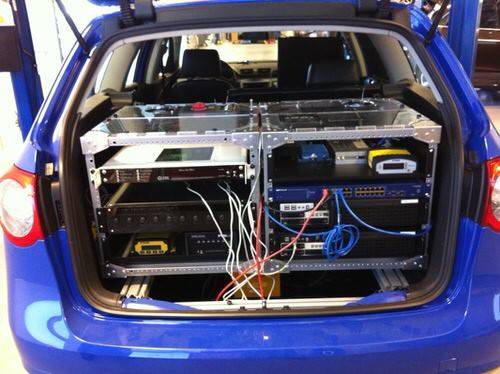Today I visited the Volkswagen Electronics Research Lab (ERL) in Silicon Valley and met the lab’s new director, Dr. Peter Oel. Cars are one of the most exciting areas of Internet innovation in 2012, with companies such as Volkswagen, Ford and Mercedes all racing to add network technologies into their cars. Up till now, that’s mostly been about integrating social services like Pandora and even Facebook into the car’s dashboard. The next step in the evolution of connected cars is much more important: making cars intelligent.

For the Volkswagen Group, Audi is the lead brand for these developments. Today I saw an Audi A8 with a beta automated driving technology called “Urban Intelligent Assist.” This isn’t yet in production, but it’s a sign of what’s to come.
The goal of the Urban Intelligent Assist project, which Audi is undertaking in collaboration with four U.S. universities, is to help the driver deal with driving conditions and navigation. As the company explained when the project launched last January, “the vision is to develop Audi models that will recognize individual motorists behind the wheel, know preferred destinations, routes the motorists have most commonly traveled and the time needed to reach appointments.” Optimizing car safety is also a priority.

According to ERL director Dr. Peter Oel, one of the biggest challenges in integrating networked technology into cars is bridging the Silicon Valley engineering culture with automotive engineering culture. With Internet technologies, startups and large companies alike (think Google) have an iterative, public beta testing process for product development. Internet companies deliberately release incomplete versions of products, then fix and improve them over time as people use the products. With cars, that’s very difficult to do because of safety. In automotive engineering, explained Dr Oel, you have to thoroughly test new technology before it goes to market.
This explains why Urban Intelligent Assist is a 3 year project. It’s at least a couple of years away from being put into production in Audi cars.
The current era of the connected car is about entertainment services and advanced mapping. The 2012 model A8, for example, features Audi connect, which turns the car into a WiFi hotspot. A key feature in the A8 is Google Earth integration.
Another test car I saw today at ERL; this one for Volkswagen and Stanford University’s Autonomous Vehicle Program.

The ERL is the largest of three Volkswagen Group research and development think-tanks around the world and, due to its base in Silicon Valley, focuses on integrating technology into cars. Other than the intelligence project, ERL is working on autonomous driving, further Google integration and distraction avoidance.
I’m looking forward to the time when my car is smarter about driving conditions and can create optimal routes for me on the fly. In the meantime, I’ll have to make do with Pandora inside my car.
(The top image is a Lego version of the old Volkswagen camper van, which Dr. Oel had on his desk and kindly let me photograph.)

















